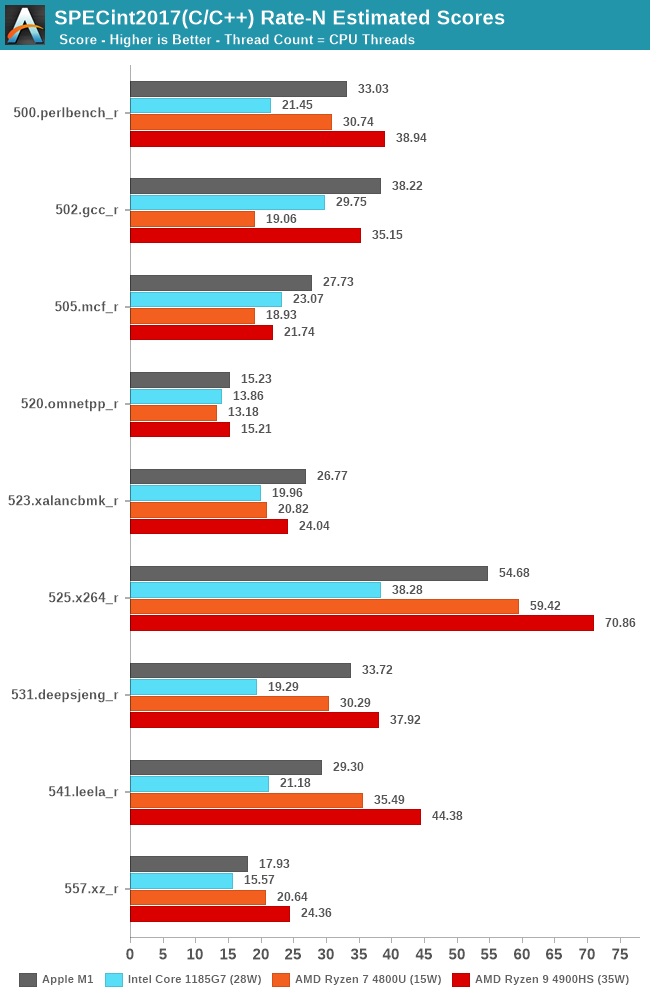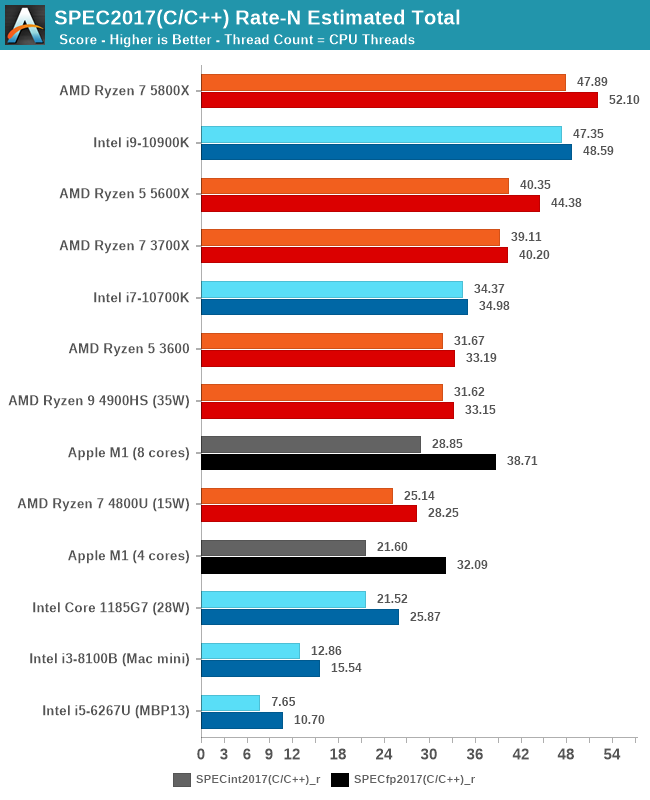The 2020 Mac Mini Unleashed: Putting Apple Silicon M1 To The Test
by Andrei Frumusanu on November 17, 2020 9:00 AM ESTSPEC2017 - Multi-Core Performance
While we knew that the Apple M1 would do extremely well in single-threaded performance, the design’s strengths are also in its power-efficiency which should directly translate to exceptionally good multi-threaded performance in power limited designs. We noted that although Apple doesn’t really publish any TDP figure, we estimate that the M1 here in the Mac mini behaves like a 20-24W TDP chip.
We’re including Intel’s newest Tiger Lake system with an i7-1185G7 at 28W, an AMD Ryzen 7 4800U at 15W, and a Ryzen 9 4900HS at 35W as comparison points. It’s to be noted that the actual power consumption of these devices should exceed that of their advertised TDPs, as it doesn’t account for DRAM or VRMs.

In SPECint2017 rate, the Apple M1 battles with AMD’s chipsets, with the results differing depending on the workload, sometimes winning, sometimes losing.

In the fp2017 rate results, we see similar results, with the Apple M1 battling it out with AMD’s higher-end laptop chip, able to beat the lower TDP part and clearly stay ahead of Intel’s design.

In the overall multi-core scores, the Apple M1 is extremely impressive. On integer workloads, it still seems that AMD’s more recent Renoir-based designs beat the M1 in performance, but only in the integer workloads and at a notably higher TDP and power consumption.
Apple’s lead against Intel’s Tiger Lake SoC at 28W here is indisputable, and shows the reason as to why Apple chose to abandon their long-term silicon partner of 15 years. The M1 not only beats the best Intel has to offer in this market-segment, but does so at less power.
I also included multi-threaded scores of the M1 when ignoring the 4 efficiency cores of the system. Here although it’s an “8-core” design, the heterogeneous nature of the CPUs means that performance is lop-sided towards the big cores. That doesn’t mean that the efficiency cores are absolutely weak: Using them still increases total throughput by 20-33%, depending on the workload, favouring compute-heavy tasks.
Overall, Apple doesn’t just deliver a viable silicon alternative to AMD and Intel, but actually something that’s well outperforms them both in absolute performance as well as power efficiency. Naturally, in higher power-level, higher-core count systems, the M1 can’t keep up to AMD and Intel designs, but that’s something Apple likely will want to address with subsequent designs in that category over the next 2 years.










682 Comments
View All Comments
shadowii - Tuesday, November 17, 2020 - link
You're not sure because you must not have read the article. May I suggest decoupling your self-esteem from chip performance from companies that don't personally care about you?PhotinoBird - Tuesday, November 17, 2020 - link
This is literally Apple's first and lowest end chip. Like, this is the CPU they put in the laptop with no fan. AMD is certainly top of the heap here in a lot of ways, and that's great. But you can't deny that Apple's first kick at the can with their least powerful and least expensive chip is very impressive, delivering extremely high performance at a powerdraw that is simply unheard of right now in laptops.YesYesNo - Tuesday, November 17, 2020 - link
This is their highest end chip.nico_mach - Tuesday, November 17, 2020 - link
Well, that's one way of putting it, but it's clearly a first effort for this segment and shot across the bow of Intel. AMD at least has a chance to catch up, and isn't losing a customer over this. Whereas Intel just got blown up. They'll be selling off the splinters soon to maximize shareholder value - they've been quite cynically milking the platform and failing, a breakup is the next logical step.YesYesNo - Tuesday, November 17, 2020 - link
There is no way to know if this is the best they can do currently or if they are holding something back.I see no reason to consider what might come out from Apple, AMD or Intel compared to what is currently out.
hugi - Tuesday, November 17, 2020 - link
Apple is replacing the processors in their entire Mac lineup in the next 24 months. There will not be M1s in the Mac Pro.mdriftmeyer - Friday, November 20, 2020 - link
That's the plan but first they have several more Intel based products in the works to extend over the next three years. And if rumors were factual it is clear they know they can't replace the Mac Pro 218 core Xeon with any possible equivalent on their part with ARM, hence the Mac Pro Mini whispered about being half the size of the current Mac Pro.If they were smart they'd drop Xeon during the transition and go Zen 3.
jbelkin - Thursday, November 19, 2020 - link
They usually announce new products around CES so look for the next batch (iMac, MBP 16"? ... 12-16 Core??) in the next 3 months.Spunjji - Tuesday, November 17, 2020 - link
For now, yes. It very soon won't be.YesYesNo - Tuesday, November 17, 2020 - link
And when it isn't i will reconsider.